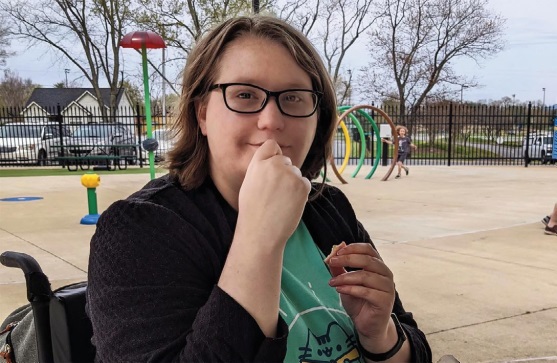IMPENDING INTERGENERATIONAL CRISIS: AMERICANS WITH DISABILITIES LACK LONG-TERM CARE PLANS
BY SAM WHITEHEAD
Thinking about the future makes Courtney Johnson nervous.
The 25-year-old blogger and college student has autism and several chronic illnesses, and with the support of her grandparents and friends, who help her access a complex network of social services, she lives relatively independently in Johnson City, Tennessee. "If something happens to them, I'm not certain what would happen to me, especially because I have difficulty with navigating things that require more red tape," she said.
Johnson said she hasn't made plans that would ensure she receives the same level of support in the future. She especially worries about being taken advantage of or being physically harmed if her family and friends can't help her – experiences she's had in the past.
“I like being able to know what to expect, and thinking about the future is a bit terrifying to me,” she said.
Johnson's situation isn't unique.
Experts say many people with intellectual and developmental disabilities do not have long-term plans for when family members lose the ability to help them access government services or care for them directly.
Families, researchers, government officials, and advocates worry that the lack of planning – combined with a social safety net that's full of holes – has set the stage for a crisis in which people with disabilities can no longer live independently in their communities. If that happens, they could end up stuck in nursing homes or staterun institutions.
"There's just potential for a tremendous human toll on individuals if we don't solve this problem," said Peter Berns, CEO of the Arc of the United States, a national disability-rights organization.
About one-quarter of adults in the U.S. live with a disability, according to the Centers for Disease Control and Prevention. Nearly three-quarters of Americans with disabilities live with a family caregiver, and about one-quarter of those caregivers are 60 or older, according to the Center on Developmental Disabilities at the University of Kansas.
But only about half of families that care for a loved one with disabilities have made plans for the future, and an even smaller portion have revisited those plans to ensure they're up to date, said Meghan Burke, an associate professor of special education at the University of Illinois in Urbana-Champaign.
"Engaging in it once is good, right? But you can't only engage in it once," she said. "It's a living document, because things change, people change, circumstances change."
Burke's research has found several barriers to planning for the future: financial constraints, reluctance to have hard conversations, trouble understanding government services. Creating plans for
people with disabilities also is a complex process, with many questions for families to answer: What are their relatives' health needs? What activities do they enjoy? What are their wishes? Where will they live?

FRAUGHT FUTURE: Courtney Johnson's grandparents and friends have helped her access social services, but she says she doesn't have plans in place to ensure she'll receive the same level of support in the future.
Burke has firsthand experience answering those questions. Her younger brother has Down syndrome, and she expects to become his primary caregiver in the future – a situation she said is common and spreads the work of caregiving. "This is an impending intergenerational crisis," she said. "It's a crisis for the aging parents, and it's a crisis for their adult offspring with and without disabilities."
Nicole Jorwic, chief of advocacy and campaigns for Caring Across Generations, a national caregiver advocacy organization, said the network of state and federal programs for people with disabilities can be "extremely complicated" and is full of holes. She has witnessed those gaps as she has helped her brother, who has autism, access services. "It's really difficult for families to plan when there isn't a system that they can rely on," she said.
Medicaid pays for people to receive services in home and community settings through programs that vary state to state. But Jorwic said there are long waitlists. Data collected and analyzed by KFF shows that queue is made up of hundreds of thousands of people across the country. Even when people qualify, Jorwic added, hiring someone to help can be difficult because of persistent staff shortages.
Jorwic said more federal money could shorten those waitlists and boost Medicaid reimbursements to health care providers, which could help with workforce recruitment. She blamed chronic underinvestment in Medicaid disability services for the lack of available slots and a dearth of workers to help people with disabilities.
“It’s going to be expensive, but this is four decades of funding that should have been done,” she said.